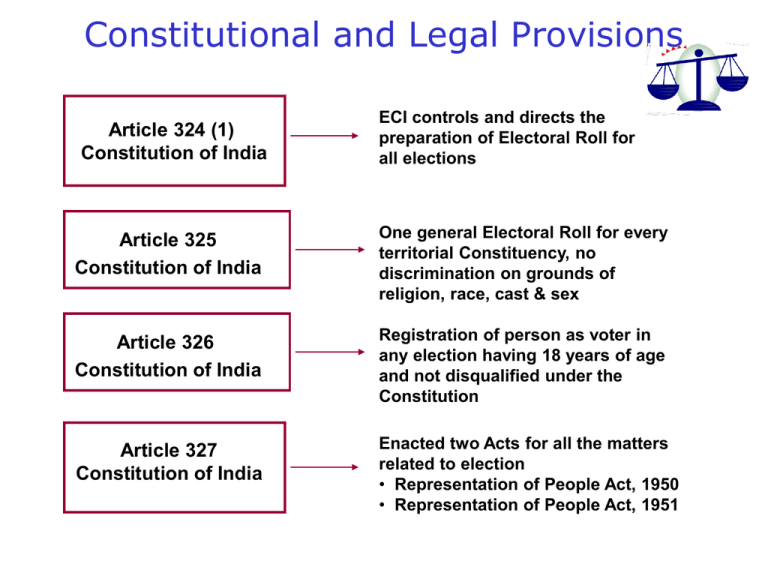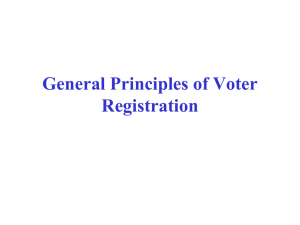
Constitutional and Legal Provisions
Article 324 (1)
Constitution of India
ECI controls and directs the
preparation of Electoral Roll for
all elections
Article 325
Constitution of India
One general Electoral Roll for every
territorial Constituency, no
discrimination on grounds of
religion, race, cast & sex
Article 326
Constitution of India
Registration of person as voter in
any election having 18 years of age
and not disqualified under the
Constitution
Article 327
Constitution of India
Enacted two Acts for all the matters
related to election
• Representation of People Act, 1950
• Representation of People Act, 1951
Constitutional & legal Provisions
Section 28
R P Act 1950
Registration of Electors
Rules (RER) 1960
Power of Central Government to make
rules with help of ECI
Such rules framed by Central
Government are called Registration of
Electors Rules (RER), 1960
The preparation and revision of Electoral Roll is carried out under this
framework of law
What did I understand?
Article 324 (1)
Constitution of
India
Article 326
Constitution of India
Registration of
Electors Rules (RER)
1960
Registration of person as
voter in any election having
18 years of age and not
disqualified under the
Constitution
The rules framed by Central
Government under the
provision of RP ACT 1950,
are called Registration of
Electors Rules (RER), 1960
ECI controls and directs
the preparation of
Electoral Roll for all
elections
What is an Electoral
Roll?
It is a listing of all those
registered to vote in a
Particular area
Electoral Rolls for Assembly and
Parliamentary Constituency
• Electoral Rolls are prepared for Assembly
Constituency (AC) under the provisions of RP
Act 1950
• No separate Electoral Roll for Parliamentary
Constituency (PC) is maintained as that PC
consists of Electoral Rolls for all its ACs
• Electoral Rolls are organized as geographically
defined Parts which are further organized into
Sections and households
• Each Part has an identified Polling Station
where electors cast their votes on the poll day
PC
AC
AC
Parts
Parts
Sections
Locality
Area
Households
Revision of Rolls
• Under Section 21, RPA 1950, Electoral Rolls are
prepared or revised :
– On the basis of qualifying date i.e. First day of January
– In any year by reference to Qualifying date as directed by
ECI
• Existing Roll continues to operate till it is
revised/updated
• ECI may direct for special revision of the Electoral
Roll for any Constituency or Part of Constituency
TYPES OF REVISION
•
•
•
•
•
Intensive Revision
Summary Revision
Partly intensive and partly summary
Special summary
Continuous updation
Types of Revision
Intensive Revision:
•
•
•
•
Done de-novo without reference to earlier
existing Roll (not a preferred method these
days)
Enumerator/BLO visits house to house
(H2H)
Draft Roll is prepared and published to
invite claims/objections
After disposal of claims, Final Roll is
published
TYPES OF REVISION
• Summary Revision:
– Done every year except if intensive revision is ordered
– Existing Roll published as draft inviting claims and
objections
– No need of house to house survey
– Designated officers sit at polling stations to receive
claims and objections
– Period of Claims and objections can be from 15 to 30
days
– After disposal of claims, Final Rolls are published
TYPES OF REVISION
Partly Intensive & Partly Summary Revision:
– Done every year except if intensive revision is
ordered
– Existing Roll published as draft inviting claims
and objections
– House to House survey is done by BLOs
– Designated officers sit at polling stations to
receive claims and objections
– Period of Claims and objections can be from 15
to 30 days
– After disposal of claims, Final Rolls are
published
TYPES OF REVISION
Special Revision:
– Due to the reason of inaccuracies like
omission, left out area etc, special revision
is carried out
– May be intensive, summary or Partly
intensive and Partly intensive revision
TYPES OF REVISION
Continuous Updation
• In between revisions any person can make a claim or
objection to the Electoral Registration Officer, and ERO
disposes of the claim or objection by following the
procedure given in the Registration of Electors Rules
1960. This is called Continuous updation.
• The process of continuous updations is stopped during
an election from the last date of filing nominations till the
declaration of results
Layout and Structure of
Electoral Roll (ER)
• ER of every AC should have title page
specifying:
– Year of preparation/revision
– Number, name and reservation status
– Extent of Constituency and number
of Parts
• Followed by table of contents indicating
serial order of area covered
• Title page is followed by Constituency
map
• Summary sheet attached at the end of
Assembly Roll
Structure
Layout
Layout and Structure of Electoral
Roll
• Electoral Roll is divided into convenient ‘Parts’ with identifiable
geographical boundary having its individual title page under
Sub-rule (1) of Rule 5, RER 1960
• This title page is followed by a sketch map of Polling Station
area in that Part
• Followed by elector details in prescribed format
• Summary sheet is provided at the end of Roll of a Part
• These Parts are further organized into Sections
• The electors details are arranged in 10-column format in ‘text
Roll’ and with photo in ‘photo Roll’
• Last Section in each Part is for overseas electors
• Last Part of Roll, lists the details of Service Voters (SVs) in
English
• Number of names added in any Part should not exceed 2000
under Rule 5 (4), RER 1960
Layout and Structure of Electoral Roll
Title Page
Sketch Map
General
Part
Elector Details
Summary
Sheet
Last Page
Service Voters








